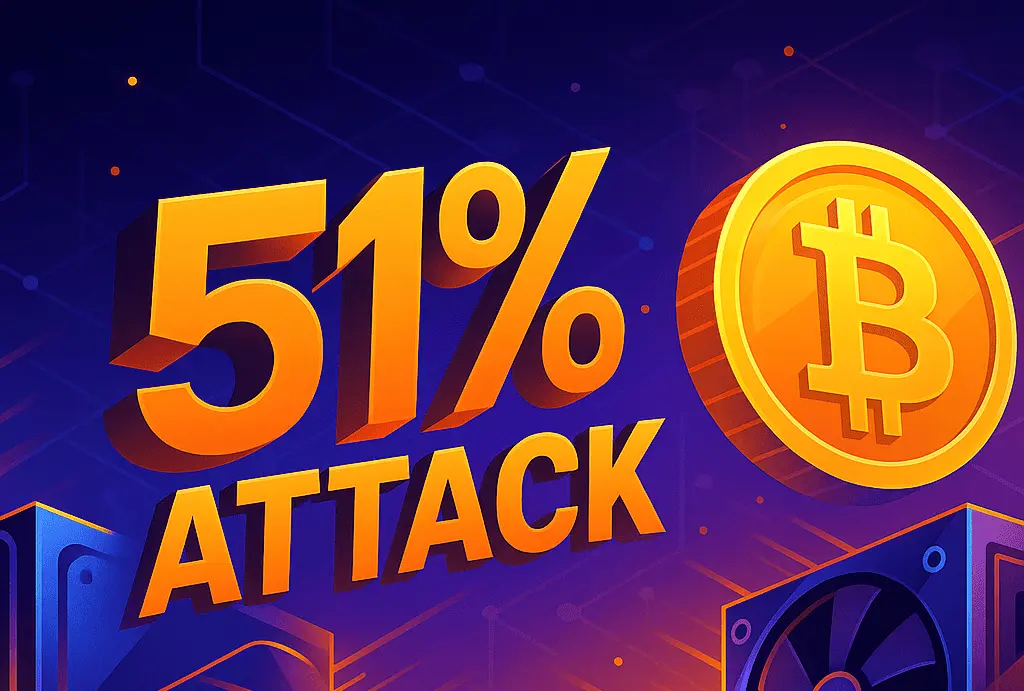What is 51% in Crypto?
In the world of cryptocurrencies, 51% in crypto refers to the infamous “51% attack,” a scenario in which a single miner or group of miners gains control of more than half of a blockchain’s computing power, also known as hash rate. By controlling the majority, these attackers can manipulate the network, rewrite transactions, and even double-spend coins.
While blockchains like Bitcoin are designed to be decentralized and secure, the possibility of a 51% attack has long haunted the crypto ecosystem. But how realistic is this threat, and what does it mean for investors and blockchain adoption?
Why 51% Matters in Blockchain Security
The security of cryptocurrencies relies heavily on decentralization. Blockchains use consensus mechanisms—such as Proof of Work (PoW) or Proof of Stake (PoS)—to verify transactions without relying on a central authority.
In Proof of Work systems, miners compete to solve cryptographic puzzles, securing the network through computational power. However, if an entity acquires 51% in crypto hash power, it can:
- Reverse transactions it made while in control (enabling double spending).
- Prevent other transactions from being confirmed.
- Halt or delay block confirmations, disrupting the system.
This doesn’t allow attackers to steal funds directly from wallets, but it undermines trust—the very foundation of blockchain technology.
Real-World Examples of 51% Attacks
Over the years, several cryptocurrencies have suffered from majority attacks, highlighting the vulnerabilities smaller blockchains face.
Bitcoin Gold (2018 & 2020)
Bitcoin Gold experienced multiple 51% attacks where hackers reorganized the blockchain and double-spent millions of dollars’ worth of coins. The network’s smaller hash rate made it easier for attackers to gain control.
Ethereum Classic (2019 & 2020)
Ethereum Classic (ETC) has been hit by several 51% attacks. In August 2020, attackers managed to reorganize over 7,000 blocks, causing chaos and leading exchanges to increase confirmation requirements for ETC transactions.
Verge (2018)
Verge, a privacy-focused coin, suffered repeated majority attacks, with attackers exploiting vulnerabilities to mint millions of tokens illegitimately.
These examples reveal that while large blockchains like Bitcoin and Ethereum are relatively safe due to their immense computational power, smaller networks remain prime targets.
How Costly Is a 51% Attack?
Executing a 51% in crypto attack is expensive and resource-intensive. The costs vary depending on the blockchain’s size and security.
For Bitcoin, the energy and hardware costs to acquire a majority hash rate are astronomical—estimated in the billions of dollars. This makes it economically irrational for attackers. However, for smaller blockchains with weaker security, costs can be as low as a few thousand dollars per hour.
Websites like Crypto51 track the real-time costs of launching a 51% attack on various blockchains, giving insight into which networks are most at risk.
51% in Crypto and Proof of Stake (PoS)
With the rise of Proof of Stake, does the 51% problem disappear? Not entirely.
In PoS systems, attackers would need to control 51% of all staked coins rather than computing power. This means buying or accumulating the majority of a network’s tokens, which is financially prohibitive on large networks but still possible on smaller projects.
Thus, while PoS shifts the economics of attacks, it doesn’t eliminate the risk entirely.
Mitigating 51% Attacks
Blockchains and developers have introduced measures to reduce the likelihood of majority attacks:
- Checkpointing: Adding manual or automatic block confirmations to prevent deep chain reorganizations.
- Hybrid Consensus: Combining PoW and PoS to strengthen defenses.
- Longer Confirmations on Exchanges: Especially for vulnerable coins, requiring more confirmations reduces the risk of double spending.
- Network Monitoring: Identifying sudden increases in hash rate that could signal an attack.
The balance between decentralization, security, and efficiency remains a challenge for blockchain architects.
Why Investors Should Care About 51% in Crypto
For investors, the possibility of a 51% attack should influence risk assessments when considering altcoins. While Bitcoin and Ethereum are relatively secure, lesser-known projects may be vulnerable.
- Market Trust: News of a successful attack often crashes a token’s price.
- Exchange Delistings: Exchanges may halt or remove trading for coins suffering repeated attacks.
- Long-Term Viability: Persistent vulnerabilities hinder adoption.
Understanding what is 51% in crypto is crucial not just for developers, but also for traders, institutional investors, and regulators assessing systemic risks.
FAQ: What is 51% in Crypto?
Q1: What is 51% in crypto and why is it dangerous?
51% in crypto refers to a majority attack where one entity controls over half of a blockchain’s network power, enabling them to alter transactions and compromise trust.
Q2: Can Bitcoin suffer a 51% attack?
Technically yes, but it’s highly unlikely. The cost of acquiring enough hash power to attack Bitcoin is prohibitively high, making it economically irrational.
Q3: Which cryptocurrencies have suffered 51% attacks?
Notable examples include Bitcoin Gold, Ethereum Classic, and Verge—networks with smaller hash rates that made them easier to exploit.
Q4: Does Proof of Stake eliminate 51% attacks?
No. In PoS systems, attackers would need to control 51% of staked coins, which remains possible, though financially difficult in larger networks.
Q5: How can investors protect themselves from 51% risks?
Research the security of the blockchain before investing. Larger, more decentralized networks are safer, while smaller projects may be more vulnerable.
Conclusion: The Future of Blockchain Security
The question of what is 51% in crypto strikes at the core of blockchain’s promise: security through decentralization. While massive networks like Bitcoin remain resilient, smaller blockchains continue to face vulnerabilities.
As technology evolves, hybrid consensus models, improved monitoring, and economic disincentives are helping safeguard against majority attacks. For investors, developers, and regulators alike, the challenge is to strike a balance between innovation and resilience.
The ultimate takeaway is clear: decentralization is only as strong as the distribution of power. And as long as majority control remains possible, the specter of 51% will continue to loom over the crypto ecosystem.

